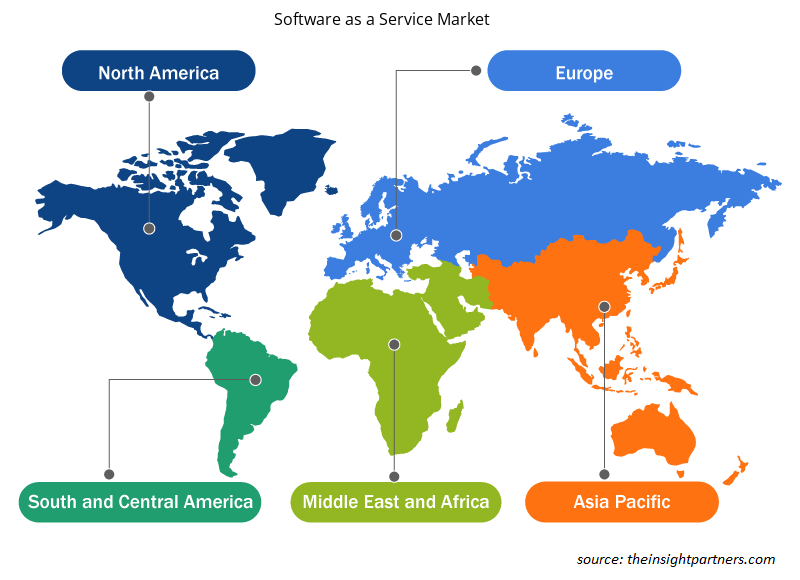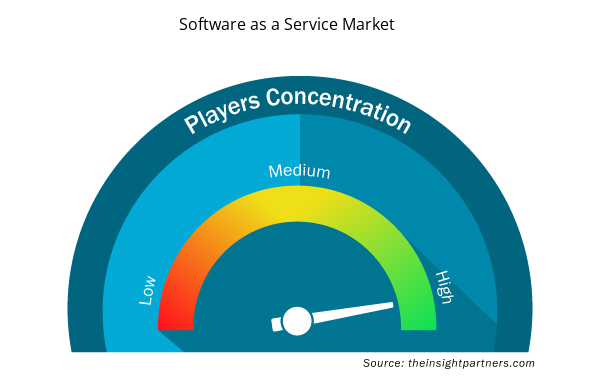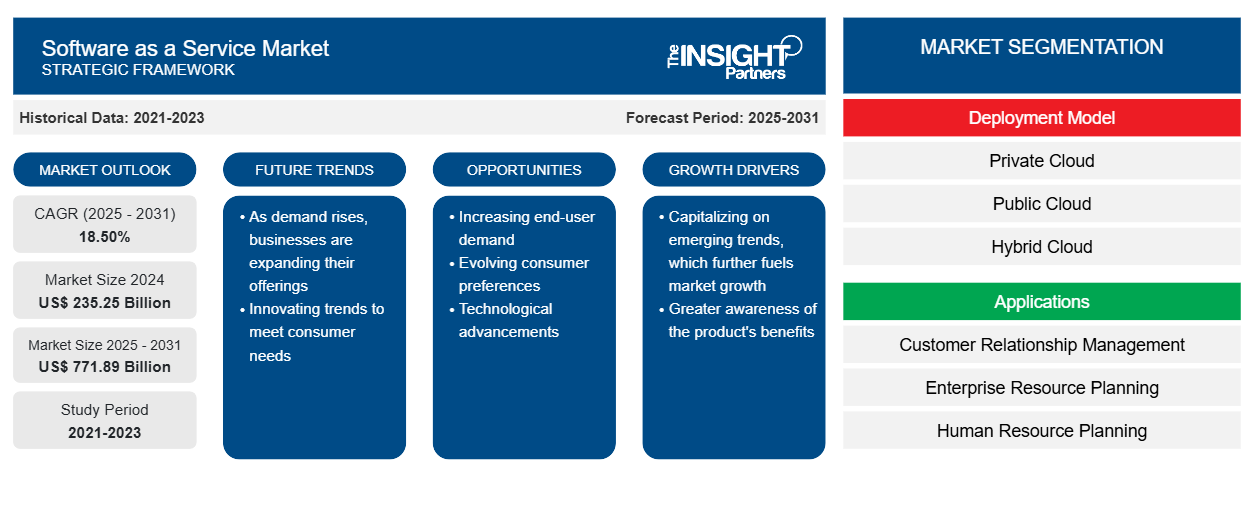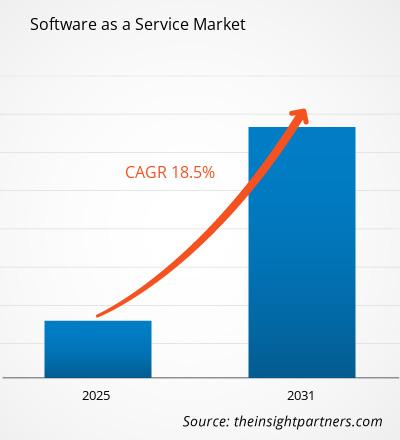Der Markt für Software as a Service soll von 167,53 Milliarden US-Dollar im Jahr 2022 auf 462,94 Milliarden US-Dollar im Jahr 2031 wachsen; von 2022 bis 2031 wird mit einer durchschnittlichen jährlichen Wachstumsrate von 18,5 % gerechnet.CAGR of 18.5% from 2022 to 2031.
SaaS-Anwendungen haben das Potenzial, kleine, mittlere und große Unternehmen effizient mit Dienstleistungen zu versorgen. Unternehmen wachsen heute schnell und müssen ihre Betriebsabläufe entsprechend der Nachfrage skalieren. Aufgrund der einfachen Skalierbarkeit, die das SaaS-Modell bietet, scheinen viele Unternehmen das SaaS-Modell für ihre verschiedenen Betriebsabläufe zu übernehmen, sei es für die Verwaltung ihrer IT-Infrastruktur, das Finanzmanagement, das Personalmanagement, die Anlagenüberwachung oder andere nützliche Bereiche. Die Einführung einer solchen modularen Struktur, mit der die IT-Infrastruktur, Speicher, Datenverarbeitung, Fabric und Virtualisierung in einer einzigen Architektur skaliert werden können, wird weltweit schnell angenommen und bietet den globalen Akteuren auf dem Markt für Software als Dienstleistung lukrative Geschäftsmöglichkeiten . Die Flexibilität, die SaaS-Modelle bieten, verschafft Unternehmen einen Wettbewerbsvorteil, indem sie sich schnell an die Anforderungen der Kunden anpassen und die erforderlichen Betriebsänderungen effizient vornehmen können. Hohe Effizienz ist heute zu einer Grundvoraussetzung für führende Unternehmen geworden, und der Einsatz von SaaS-Modellen gibt ihnen die Möglichkeit, flexibel und effizient zu sein. Die von SaaS-Anbietern verwendeten Tools sind in der Regel robuster und aktueller als die, die den meisten lokalen Unternehmen zur Verfügung stehen. Diese Faktoren beeinflussen das Wachstum des Marktes für Software als Dienstleistung.
Außerdem nutzen SaaS-Anbieter redundante Server zur Datensicherung. Im Falle einer Störung in der Cloud werden Benutzer automatisch und ohne Leistungseinbußen auf einen Backup-Server umgeleitet. Darüber hinaus führen SaaS-Anbieter regelmäßige Datensicherungen durch. Da es nur eine einzige Version der Software gibt, werden in der Regel mehr Ressourcen des Anbieters darauf verwendet, Probleme/Fehler und die entsprechenden Patches/Fixes zu identifizieren, die zur Behebung dieser Probleme erforderlich sind. Diese Faktoren treiben das Wachstum des Software-as-a-Service-Marktes weiter voran.
SaaS ist eine fortschrittliche Technologie, die traditionelle On-Premise-Softwaresysteme weltweit in eine moderne Cloud-basierte Lösung umwandelt. Neben dem geringeren Aufwand für die Ausführung eines Prozesses sowie die Installation und den Kauf von Software hilft es einem Unternehmen auch, Kosten zu minimieren und den Umsatz zu maximieren. Folglich haben private Organisationen weltweit das Potenzial dieser Dienste erkannt und Cloud-basierte Dienste entwickelt. Diese Faktoren fördern das Wachstum des Marktes.
Passen Sie diesen Bericht Ihren Anforderungen an
Sie erhalten kostenlos individuelle Anpassungen an jedem Bericht, einschließlich Teilen dieses Berichts oder einer Analyse auf Länderebene, eines Excel-Datenpakets sowie tolle Angebote und Rabatte für Start-ups und Universitäten.
- Holen Sie sich die wichtigsten Markttrends aus diesem Bericht.Dieses KOSTENLOSE Beispiel umfasst eine Datenanalyse von Markttrends bis hin zu Schätzungen und Prognosen.
Angesichts der wachsenden Bedenken hinsichtlich der Sicherheit und Vertraulichkeit von Daten wurde ein Bereitstellungsmodell für private Clouds entwickelt, das sich jedoch als sehr kostspielig erwies. Nicht alle Daten von Unternehmen können unternehmenskritisch und vertraulich sein. Verschiedene Datentypen erfordern unterschiedliche Sicherheitsstufen. Die Flexibilität, weniger kritische Daten in der öffentlichen Cloud und unternehmenskritische Daten in der Hybrid Cloud zu speichern, macht die Einführung für Unternehmen äußerst attraktiv. Der Bankensektor, der große Mengen vertraulicher Daten speichern muss, ist das Geschäftssegment, das am meisten von der Einführung des Bereitstellungsmodells für die Hybrid Cloud profitiert. Das Hybrid-Cloud-Modell dürfte daher im Prognosezeitraum rasant wachsen und dem Marktanteil von Hybrid-Software als Service lukrative Wachstumschancen bieten.
Regionale Analyse des Software-as-a-Service-Marktes
Aus regionaler Sicht hatte Nordamerika im Jahr 2021 den größten Anteil am globalen Software-as-a-Service-Markt. Angesichts der steigenden Kundennachfrage nach qualitativ hochwertigen Produkten und Dienstleistungen entwickeln nordamerikanische Unternehmen ständig Innovationen, um ihre Kunden bestmöglich zu bedienen. Dies erhöht die Nachfrage nach Lösungen wie CRM und ERP. Darüber hinaus trägt die Präsenz von SaaS-Anbietern wie Microsoft Corporation, Amazon Web Services, Symantec Corporation, IBM, ORACLE, ADP LLC, Workday und Google in der gesamten Region weiter zum schnellen Wachstum des Marktes bei.
Regionale Einblicke zum Software-as-a-Service-Markt
Die regionalen Trends und Faktoren, die den Software-as-a-Service-Markt im Prognosezeitraum beeinflussen, wurden von den Analysten von Insight Partners ausführlich erläutert. In diesem Abschnitt werden auch die Marktsegmente und die Geografie von Software-as-a-Service in Nordamerika, Europa, im asiatisch-pazifischen Raum, im Nahen Osten und Afrika sowie in Süd- und Mittelamerika erörtert.

- Holen Sie sich regionale Daten zum Software-as-a-Service-Markt
Umfang des Software-as-a-Service-Marktberichts
| Berichtsattribut | Details |
|---|---|
| Marktgröße im Jahr 2023 | 198,52 Milliarden US-Dollar |
| Marktgröße bis 2031 | 771,89 Milliarden US-Dollar |
| Globale CAGR (2023 - 2031) | 18,50 % |
| Historische Daten | 2021-2022 |
| Prognosezeitraum | 2024–2031 |
| Abgedeckte Segmente | Nach Bereitstellungsmodell
|
| Abgedeckte Regionen und Länder | Nordamerika
|
| Marktführer und wichtige Unternehmensprofile |
|
Marktteilnehmerdichte: Der Einfluss auf die Geschäftsdynamik
Der Markt für Software-as-a-Service wächst rasant. Dies wird durch die steigende Nachfrage der Endnutzer aufgrund von Faktoren wie sich entwickelnden Verbraucherpräferenzen, technologischen Fortschritten und einem größeren Bewusstsein für die Vorteile des Produkts vorangetrieben. Mit der steigenden Nachfrage erweitern Unternehmen ihr Angebot, entwickeln Innovationen, um die Bedürfnisse der Verbraucher zu erfüllen, und nutzen neue Trends, was das Marktwachstum weiter ankurbelt.
Die Marktteilnehmerdichte bezieht sich auf die Verteilung der Firmen oder Unternehmen, die in einem bestimmten Markt oder einer bestimmten Branche tätig sind. Sie gibt an, wie viele Wettbewerber (Marktteilnehmer) in einem bestimmten Marktraum im Verhältnis zu seiner Größe oder seinem gesamten Marktwert präsent sind.
Die wichtigsten Unternehmen auf dem Software-as-a-Service-Markt sind:
- Google, Inc.
- Oracle Corporation
- Amazon.com, Inc.
- Salesforce.com, Inc.
- Fujitsu Ltd.
Haftungsausschluss : Die oben aufgeführten Unternehmen sind nicht in einer bestimmten Reihenfolge aufgeführt.

- Überblick über die wichtigsten Akteure auf dem Software-as-a-Service-Markt
Markteinblicke – Software-as-a-Service-Markt
Anwendungsbasierte Erkenntnisse
Basierend auf der Anwendung ist der Software-as-a-Service-Markt in Customer Relationship Management (CRM), Enterprise Resource Planning (ERP), Human Resource Planning (HRP), Supply Chain Management (SCM) und andere unterteilt. Das CRM-Segment machte im Jahr 2021 den größten Anteil des globalen Software-as-a-Service-Marktes aus. Mit seinen zahlreichen Vorteilen hat SaaS CRM die Wahrnehmung der Unternehmen hinsichtlich der Verwendung und Kontrolle von Front-Office-Softwaresystemen erfolgreich verändert. Insbesondere für CRM bieten die SaaS-Anwendungen verschiedene Vorteile wie eine optimale Infrastruktur ohne Investitionsaufwand, kürzere Implementierungs- und Integrationszeiten mit vorhandenen Systemen, Software-Upgrades ohne nennenswerte Engpässe, konstante Systemverfügbarkeit und Personal rund um die Uhr. Es verfolgt und verwaltet aktiv Kundeninformationen, erfasst Kunden-E-Mails, vereinfacht sich wiederholende Aufgaben und liefert sofortige Erkenntnisse und Empfehlungen. Wenn das Geschäft wächst, hilft CRM bei der Anpassung von Funktionen. Laut Salesforce – einem der führenden CRM-Anbieter – helfen die Lösungen ihren Kunden im Durchschnitt, ihren Umsatz um 30 % zu steigern, und die Kundenzufriedenheit steigt um 40 %. Diese Faktoren tragen weiter zum Wachstum des Segments bei.
Die Akteure auf dem Software-as-a-Service-Markt konzentrieren sich hauptsächlich auf die Entwicklung fortschrittlicher und effizienter Produkte.
- Im Dezember 2022 gab die Microsoft Corporation ihre 10-jährige Partnerschaft mit LSEG bekannt, um Datenanalyse- und Cloud-Infrastrukturlösungen anzubieten.
- Im November 2022 kündigte Shadow die Einführung seines neuen Cloud-Speicherdienstes namens Shadow Drive an.
Der Software-as-a-Service-Markt ist in fünf große Regionen unterteilt: Nordamerika, Europa, Asien-Pazifik (APAC), Naher Osten und Afrika sowie Südamerika. Im Jahr 2021 führte Nordamerika den Markt mit einem beträchtlichen Umsatzanteil an, gefolgt von Europa. Darüber hinaus wird erwartet, dass der Asien-Pazifik-Raum von 2022 bis 2031 die höchste durchschnittliche jährliche Wachstumsrate im Software-as-a-Service-Markt verzeichnet.
Zu den wichtigsten globalen Akteuren auf dem Software-as-a-Service-Markt zählen ADP LLC, Amazon.com Inc, Google Inc, IBM Corporation, Microsoft Corporation, Oracle Corporation, Salesforce.com Inc, SAP SE, Fujitsu Limited und Workday Inc.
- Historische Analyse (2 Jahre), Basisjahr, Prognose (7 Jahre) mit CAGR
- PEST- und SWOT-Analyse
- Marktgröße Wert/Volumen – Global, Regional, Land
- Branche und Wettbewerbsumfeld
- Excel-Datensatz



Report Coverage
Revenue forecast, Company Analysis, Industry landscape, Growth factors, and Trends

Segment Covered
This text is related
to segments covered.

Regional Scope
North America, Europe, Asia Pacific, Middle East & Africa, South & Central America

Country Scope
This text is related
to country scope.
Trends and growth analysis reports related to Technology, Media and Telecommunications : READ MORE..
The List of Companies - Software as a Service (SaaS) Market
- Google, Inc.
- Oracle Corporation
- Amazon.com, Inc.
- Salesforce.com, Inc.
- Fujitsu Ltd.
- Workday, Inc.
- ADP, LLC
- IBM Corporation
- SAP SE
- Microsoft Corporation
The Insight Partners performs research in 4 major stages: Data Collection & Secondary Research, Primary Research, Data Analysis and Data Triangulation & Final Review.
- Data Collection and Secondary Research:
As a market research and consulting firm operating from a decade, we have published and advised several client across the globe. First step for any study will start with an assessment of currently available data and insights from existing reports. Further, historical and current market information is collected from Investor Presentations, Annual Reports, SEC Filings, etc., and other information related to company’s performance and market positioning are gathered from Paid Databases (Factiva, Hoovers, and Reuters) and various other publications available in public domain.
Several associations trade associates, technical forums, institutes, societies and organization are accessed to gain technical as well as market related insights through their publications such as research papers, blogs and press releases related to the studies are referred to get cues about the market. Further, white papers, journals, magazines, and other news articles published in last 3 years are scrutinized and analyzed to understand the current market trends.
- Primary Research:
The primarily interview analysis comprise of data obtained from industry participants interview and answers to survey questions gathered by in-house primary team.
For primary research, interviews are conducted with industry experts/CEOs/Marketing Managers/VPs/Subject Matter Experts from both demand and supply side to get a 360-degree view of the market. The primary team conducts several interviews based on the complexity of the markets to understand the various market trends and dynamics which makes research more credible and precise.
A typical research interview fulfils the following functions:
- Provides first-hand information on the market size, market trends, growth trends, competitive landscape, and outlook
- Validates and strengthens in-house secondary research findings
- Develops the analysis team’s expertise and market understanding
Primary research involves email interactions and telephone interviews for each market, category, segment, and sub-segment across geographies. The participants who typically take part in such a process include, but are not limited to:
- Industry participants: VPs, business development managers, market intelligence managers and national sales managers
- Outside experts: Valuation experts, research analysts and key opinion leaders specializing in the electronics and semiconductor industry.
Below is the breakup of our primary respondents by company, designation, and region:

Once we receive the confirmation from primary research sources or primary respondents, we finalize the base year market estimation and forecast the data as per the macroeconomic and microeconomic factors assessed during data collection.
- Data Analysis:
Once data is validated through both secondary as well as primary respondents, we finalize the market estimations by hypothesis formulation and factor analysis at regional and country level.
- Macro-Economic Factor Analysis:
We analyse macroeconomic indicators such the gross domestic product (GDP), increase in the demand for goods and services across industries, technological advancement, regional economic growth, governmental policies, the influence of COVID-19, PEST analysis, and other aspects. This analysis aids in setting benchmarks for various nations/regions and approximating market splits. Additionally, the general trend of the aforementioned components aid in determining the market's development possibilities.
- Country Level Data:
Various factors that are especially aligned to the country are taken into account to determine the market size for a certain area and country, including the presence of vendors, such as headquarters and offices, the country's GDP, demand patterns, and industry growth. To comprehend the market dynamics for the nation, a number of growth variables, inhibitors, application areas, and current market trends are researched. The aforementioned elements aid in determining the country's overall market's growth potential.
- Company Profile:
The “Table of Contents” is formulated by listing and analyzing more than 25 - 30 companies operating in the market ecosystem across geographies. However, we profile only 10 companies as a standard practice in our syndicate reports. These 10 companies comprise leading, emerging, and regional players. Nonetheless, our analysis is not restricted to the 10 listed companies, we also analyze other companies present in the market to develop a holistic view and understand the prevailing trends. The “Company Profiles” section in the report covers key facts, business description, products & services, financial information, SWOT analysis, and key developments. The financial information presented is extracted from the annual reports and official documents of the publicly listed companies. Upon collecting the information for the sections of respective companies, we verify them via various primary sources and then compile the data in respective company profiles. The company level information helps us in deriving the base number as well as in forecasting the market size.
- Developing Base Number:
Aggregation of sales statistics (2020-2022) and macro-economic factor, and other secondary and primary research insights are utilized to arrive at base number and related market shares for 2022. The data gaps are identified in this step and relevant market data is analyzed, collected from paid primary interviews or databases. On finalizing the base year market size, forecasts are developed on the basis of macro-economic, industry and market growth factors and company level analysis.
- Data Triangulation and Final Review:
The market findings and base year market size calculations are validated from supply as well as demand side. Demand side validations are based on macro-economic factor analysis and benchmarks for respective regions and countries. In case of supply side validations, revenues of major companies are estimated (in case not available) based on industry benchmark, approximate number of employees, product portfolio, and primary interviews revenues are gathered. Further revenue from target product/service segment is assessed to avoid overshooting of market statistics. In case of heavy deviations between supply and demand side values, all thes steps are repeated to achieve synchronization.
We follow an iterative model, wherein we share our research findings with Subject Matter Experts (SME’s) and Key Opinion Leaders (KOLs) until consensus view of the market is not formulated – this model negates any drastic deviation in the opinions of experts. Only validated and universally acceptable research findings are quoted in our reports.
We have important check points that we use to validate our research findings – which we call – data triangulation, where we validate the information, we generate from secondary sources with primary interviews and then we re-validate with our internal data bases and Subject matter experts. This comprehensive model enables us to deliver high quality, reliable data in shortest possible time.


 Holen Sie sich ein kostenloses Muster für diesen Bericht
Holen Sie sich ein kostenloses Muster für diesen Bericht